




IMAGES OF GARGUNNOCK
Photographers, professional, Amateur or just snap-


In 1910 the village benefited greatly from the generosity of its minister, the Rev Dr Robert Stevenson who paid for the installation and first 2 year’s maintenance of a piped water supply system after the local council declined to do so. Until then water was drawn from the burn or garden wells.
In addition his nephews paid for the drinking fountain seen in the background as a memorial to Rev Stevenson’s mother. The dedication ceremony was attended by villagers and the great & the good from the surrounding estates and further afield. Afterwards they all adjourned to the school where speeches were made and refreshments served.
This photo was of great interest to me as, according to a letter written by Stevenson decades later my grandfather Jack (John) McLaren was in it, but he didn’t clearly define which figure he was. I didn’t have a photo of him at the time so was stumped until one day I opened a packet of relatively modern prints and out fell a studio photo of him. I already knew his wife, my Granny, was to the left front of the platform in a long black dress, he turned out to be the chap in bowler hat at the right front, just behind the church organist and his wife wearing a big hat!
Courtesy of Gargunnock Parish Church
By the 1920s bus companies were springing up all over the place and seriously challenging the railways. Who would want to trudge all the way down to Gargunnock Station for a train when a bus came right into the village Square? Coal, previously brought from the station by horse & cart, could now be delivered direct to your house by lorry.
As a consequence, in the mid 30s the station closed to passenger traffic and by the early 1960s the line had been axed, the track lifted and bridges removed.
Courtesy of Cathie Cowan
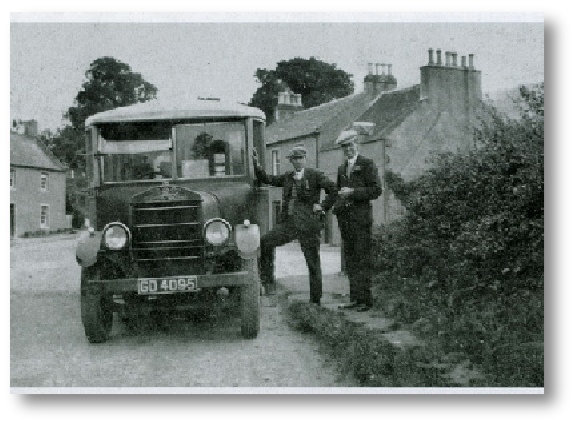
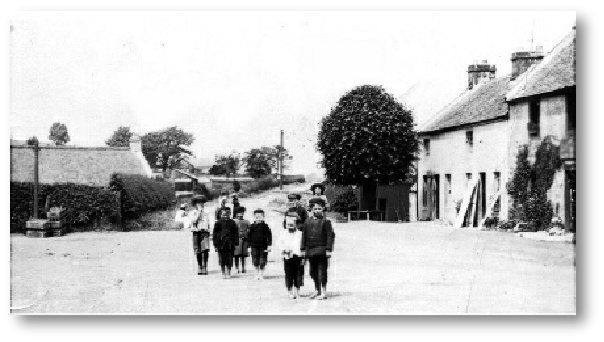
A group of mainly barefoot and curious Gargunnock children line up for the camera in this pre-
At the left there is no sign of the drinking fountain or its access gate, erected in 1910. There is, however a short cast iron lamp-
The old stone bridge on Leckie Road (School Road in these days, similar to the one on Main St., still carries traffic to the school and beyond while in the distance a single wooden pole carries the telegraph wires heading for Mrs Binnies shop, Post and Telegraph Office, at that time situated in the eastern end of what is now our local supermarket. Directly behind that pole and further along the road can be seen a relatively young fir tree and an oak tree, both of which still stand in Leckie Road over 100 years later.
Courtesy of the late Miss Sylvia Miller
An example of perhaps an original 18th century house, demolished when a new one was built some time back.
Of local red sandstone, random rubble construction, it would be thatched originally, the thatch being replaced by red pan-
The ghost of an adjoining, slightly smaller building can be seen on the gable end. Latterly this building served as a garage for Mansefield, the house beyond, at one time the United Free Church Manse.
Out of site just beyond Mansefield is a house, Carseview, which was for a time the village school until 1858 when a new one was built (now the Community Centre)
Courtesy of Angus Mailer
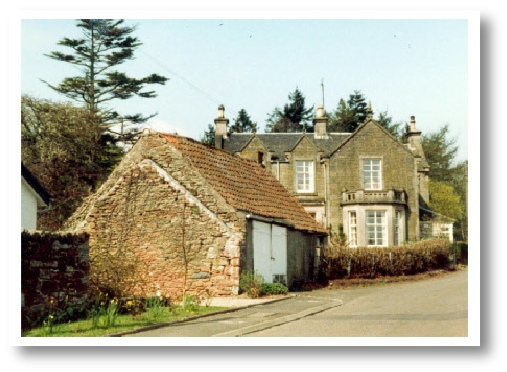
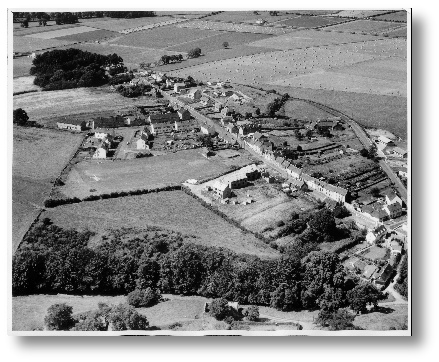
This is an aerial photo taken around 1966 when the village was just beginning to expand. It clearly shows the old strip feus on the north side of the Main St and the way in which Leckie Road, a very early bypass of the steep Main St in the early 1800s, cut through them. Still discernable are similar feus to the south but already most of the houses have gone and construction is underway on McNeil Crescent with 3 blocks in-
Further up Stevenson/Stark St built in the late 40s/early 50s can be seen while across, the road in the field known as Loftbrae, a number of individual private houses have already been built.
It is evident that there are few trees in the village at that time, gardens being used for more useful purposes. Contrast that with nowadays when trees are rife and the many fine views available then are but a memory now. Very few cars are visible either. Another great contrast!
For a higher resolution version click on the photo
Courtesy of Mr Watt
By far the oldest photograph in Gargunnock is this one hanging in the church. It shows the Rev John Stark who served here from 1844 to 1888. Duncan McNeil had this to say about him in 1947 when he gave a talk in the new church hall about the history of Gargunnock and some of its characters.
A well-
His name lives on locally in Stark Street, off Stevenson St.
Courtesy of Gargunnock Parish Church
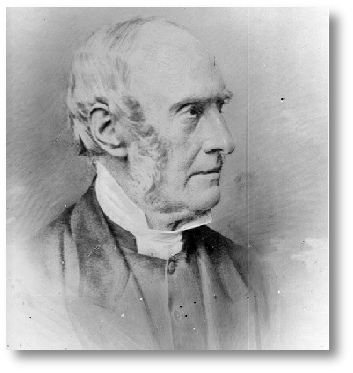
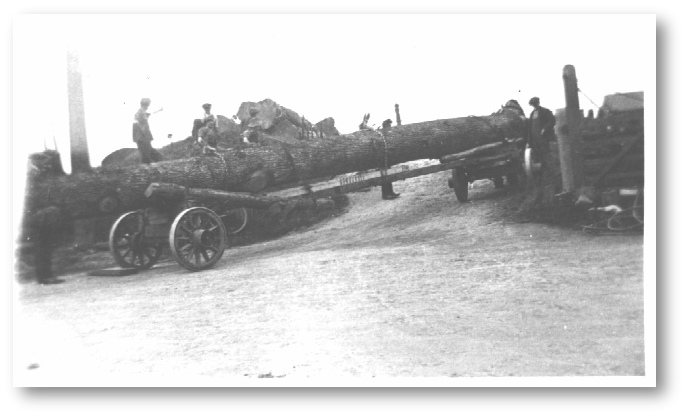
Gargunnock Station Sidings
This is how big trees were transported back then. Attach a bogie at both ends and hook up the horses. That big tree is too big for the adjacent sawmill I think so it is about to join another one on a railway wagon in a siding in the background.
The saw mil (John McLaren and Sons) probably employed about 20 men in its heyday and at the end of each day a procession of bicycles could be seen heading back to the village, often with a few bits of wood for the fire strapped on at the back.
Courtesy Alec Paton

McLaren’s Sawmill (John McLaren & Sons)
This sawmill constructed around 1920, replaced an older one beside the McLaren’s house, Viewfield, up Manse Brae in the village. It employed about 20 men in its day and here was manufactured a wide range of timber products from pit props and lids to carts, barrows and even coffins.
Within the mill was an amazingly complex network of shafts, wheels and belts designed to transmit the driving power of a stationery steam engine to all the machinery contained therein. Circular saws, planer, lathes, mortice machines, drills etc. The funnel of the engine can be seen poking through the roof. The sound of it all and the steam whistle to signify the end of the day could be heard from the village if the wind was right. Just beyond the mill was the river and the bridge and to its south, off to the right, the railway station.
Courtesy Johan Mailer
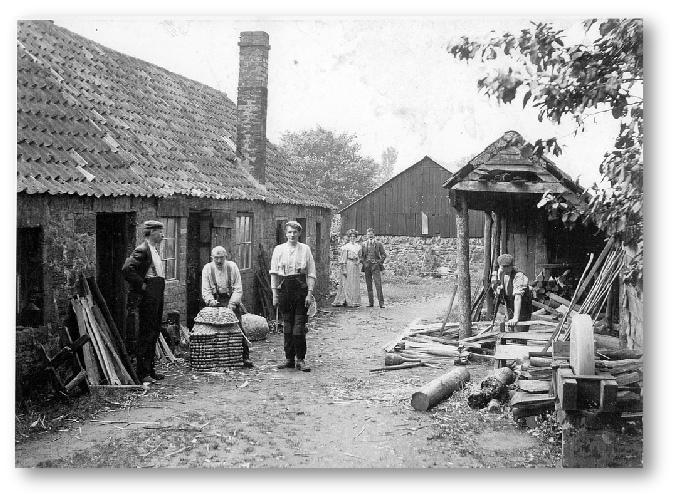
The basket making industry appeared (or was encouraged to come from down south) in the second half of the 19th century and stayed here ‘till the early 30s when the last owner died. Here a pile of the spale baskets can be seen in the centre. The building on the left was called the basket “shop” Another stood to the right, out of camera shot. The precarious lean-
The young couple in the background no doubt belong to the Travis family who owned the business. An employee of theirs, called Craik, left to start his own basket business in a house close to the Pub.
Courtesy Jean Travis
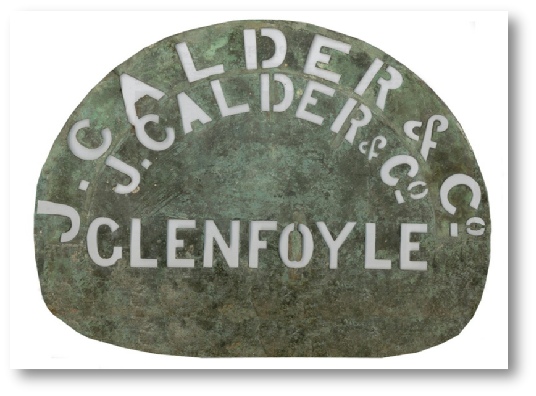
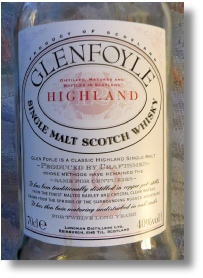
Gargunnock’s Glenfoyle Single Malt Scotch Whisky
Founded in 1825 from Westerkepp Distillery the name changed to Dasherhead Distillery and Glenfoyle Distillery in 1926. Also known as Gargunnock Distillery. The warehouses were used by Tullibardine Distillery after 1923.
This is an old metal stencil used to paint on the barrels. A single malt was made, intended for blending and 30,000 gallons were produced per annum. Walter for the whisky was piped from the hills behind the village. The manager of the distillery lived, appropriately enough, in Glenfoyle Cottage in the Square.

Quarry Crusher and Screening Plant
Another industry now long gone is that of quarrying at Dinning Quarry, still plainly seen up on the hill behind the village. Operations ceased in the 30s after a fatality.
This part of the operation stood down at what became later a sawmill site and the concrete foundations for it can still be seen to this day. Stone from the quarry was fed into this machine which crushed it then screened (graded) it into different sizes for various uses. No doubt it had plenty of business in the 1920s when there was a lot of road improvement work underway. From this point up to the quarry the road becomes very steep so stone was transported down to the crusher via an overhead cable system in hutches, small metal buckets.
The man at the left hand end is Andrew Rough.
Courtesy Anne Preston

Dinning Quarry
Up at the quarry end of the operation rock was blasted out of the rock face then loaded into these small steel hutches for transporting via an overhead wire system on pylons down to the crusher far below. The concrete footings can still be seen to this day.
Courtesy Anne Preston
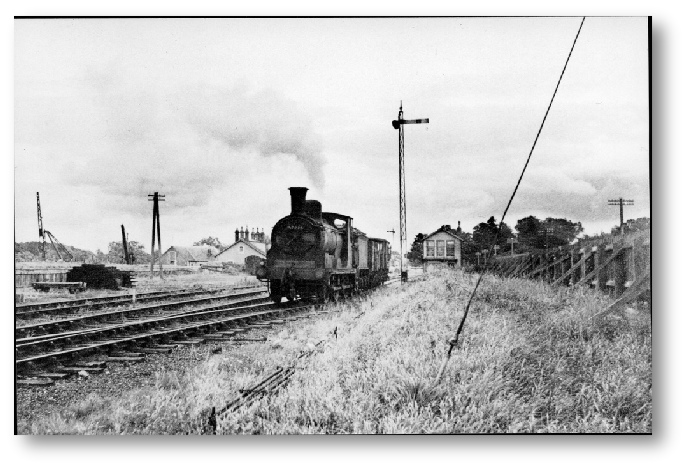
Gargunnock Railway Station
Opened in the mid 19th century, the Forth and Clyde railway was intended to link the Fife coalfields with the Clyde. Passenger services were popular too but eventually were withdrawn in the mid 1930s due to competition from buses. Later in the early 60s the line was closed permanently.
The house to the left of the engine is that of the Stationmaster and the signal box was, after closure, used for a time by a local artist, Gary Grey. The sawmill is just out of sight to the left.
Courtesy Arthur Webster

Elsie Boag’s Shop
This is the house, near the head of the brae, called Ferndale which, for about 40 years or so was a shop run by Elsie Boag. Elsie has anything from a needle to an anchor (plus paraffin) and she was open from 7 am to 10 pm….and even in emergency beyond that if you went round the back! Through that door was a wee corridor with a stuffed alligator on the wall then you turned left into the shop. It had a tiny counter and jars of sweets on shelves (after sugar came off the rationing) Sherbet was sold in a wee conical paper poke and Woodbines in fives. Bread was kept in the front bedroom, delivered by Andy Cameron (later the comedian, remember?) from his Welma van and Duncan’s lemonade was sold in glass bottles you returned because there was a 3d deposit charged on them. Oh happy days! This is the last of four houses I lived in on Main St before building my current one at the bottom of the long garden behind.
Courtesy Sylvia Miller
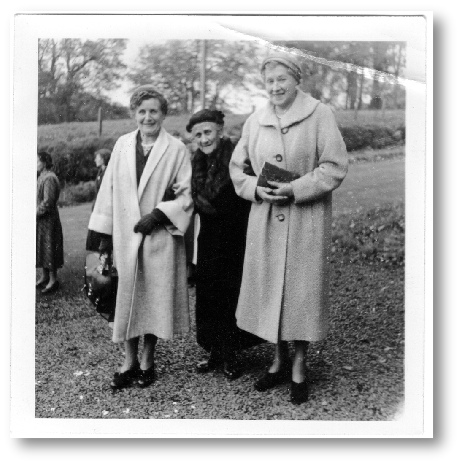
Having shown a photo of Elsie Boag and her shop it seems appropriate to show Roseville, Mrs Hunter’s shop, just down the street and Mrs Hunter herself. Here she is on the right at the front of the church. The other two are Mrs Betty McLaren and her mother Mrs Johan Strachan. Mrs Hunter’s shop had a phone in the corridor which was widely used instead of the public telephone. There was a wee wooden box beside it to receive the cost of your call. I remember that Mrs Hunter’s cooker in the back kitchen was unusual in being of the paraffin fuelled variety with three separate burners fuelled from a common tank. I don’t recall what the oven arrangements were.
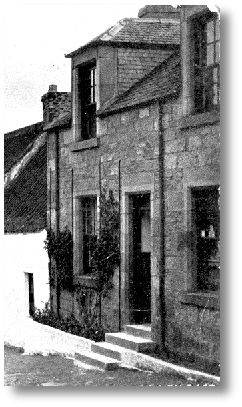
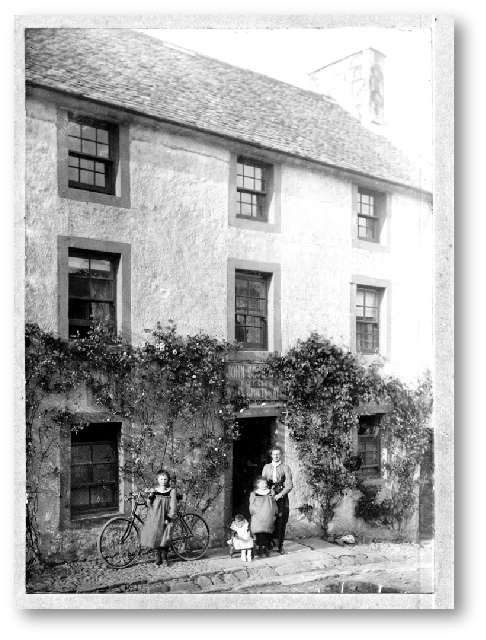
Gargunnock Public House
At one time Gargunnock had four Inns; two in the Square; one in Millthread Cottage and this one in Main St, the only one to survive to this day and now named the Gargunnock Inn.
The photo is dated circa 1900, the name above the door is John Coughbrough and the lady is Jenny Coubrough who ran the Pub until the 1930s when it was taken over by a relative, Mary (Molly) Simpson. Thereafter it was known as Molly's until she retired another 40 years later.
The wee boy sitting on a chair is Geordie Strang who eventually married “Molly” Simpson.
Note the fine stone lining to the footpath and the old stone sheugh or open drain.
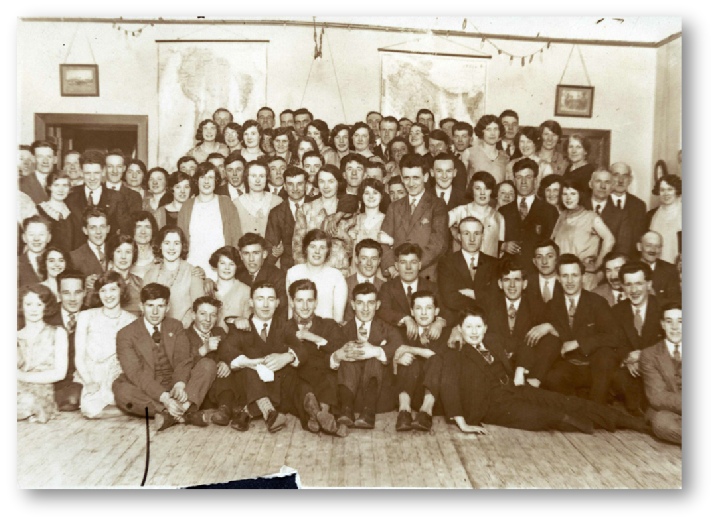
Dance in the School
Before the church hall was created in 1939 the only public hall available was the school. The drawback was that all the desks had to be cleared away first and put back afterwards.
Here can be seen a good selection of villagers out to enjoy themselves, no doubt on a Saturday night. Note the maps hanging at the back and the bare floorboards.
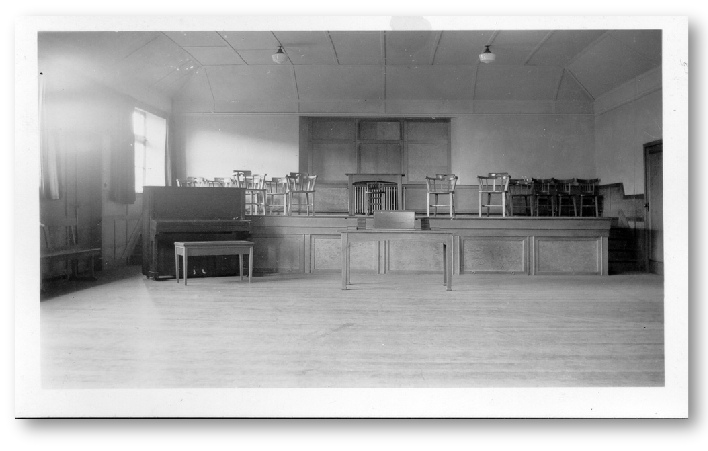
The New Church Hall
This photo was probably taken by a proud minister soon after the conversion of the old Free Church in Station Road as there are no stage curtains in evidence. I know he was keen on photography because he introduced me to the delights of developing and printing when I was in my teens.
From 1939 to about 2000 this hall hosted a tremendous number of events of all sorts, dances, concerts, Sunday School, various clubs, flower shows. Seating was on wooden benches stored underneath the stage when badminton was being played. This was the main hall but there was also a lesser hall to the right.
Funding for the hall was by public subscription but a substantial donation from a former minister, Rev Robert Stevenson really set the wheels in motion. Towards the end it suffered from under-
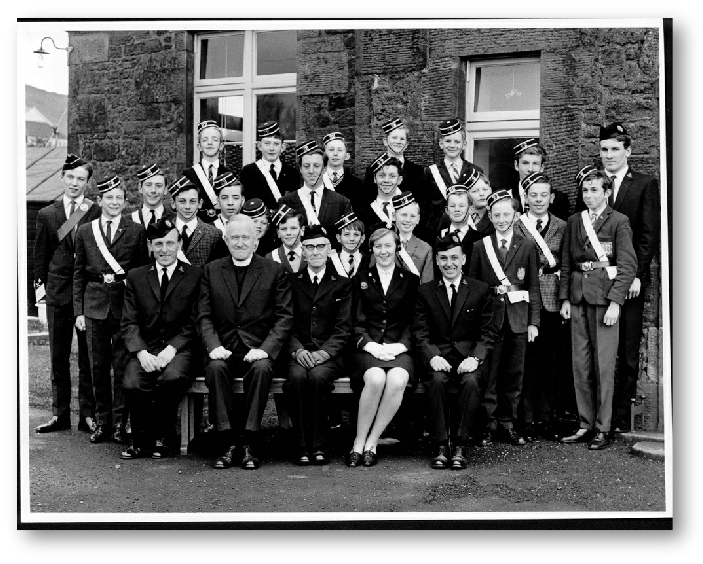
Gargunnock Boys Brigade Company
Typical of the organisations using the hall was the 22nd Co. Boys Brigade, Seen here with officers Dick Taylor, Minister Rev. William Turner BD, An inspecting officer and William Coote. If you are local you will have no difficulty naming most of the boys here. Most will be in their 50s or 60s now. The lady is of course Anne Muirhead who ran the Life Boys.
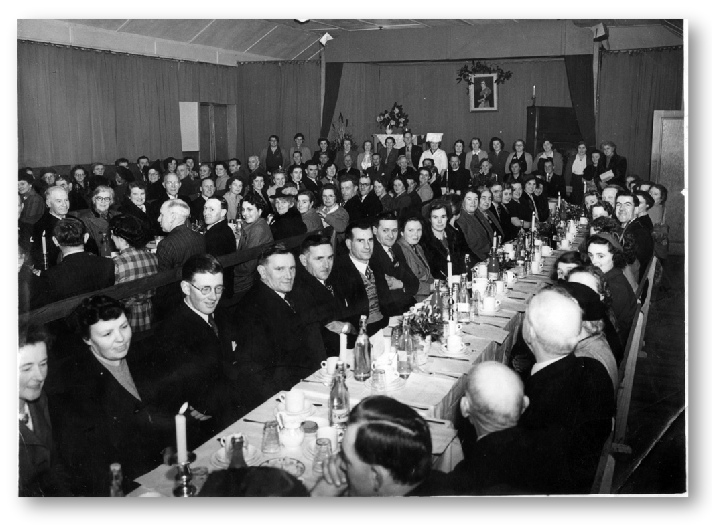
Burns Night at the Church Hall
….and not a drop of alchohol in sight as it wasn’t allowed! A good selection of villagers are shown here and most can be named too. Note the installation of stage curtains by this time.
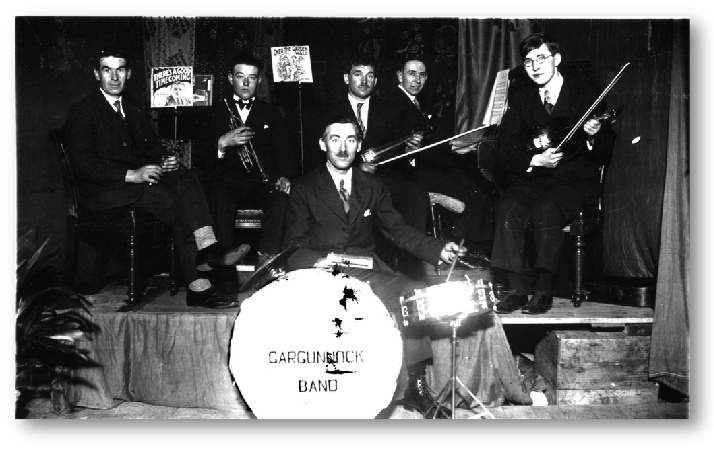
The Gargunnock Band
The band played for many dances here. Hamish W Ross was on drums, Jim Grant the church organist was on piano and Duncan McNeil played flute.
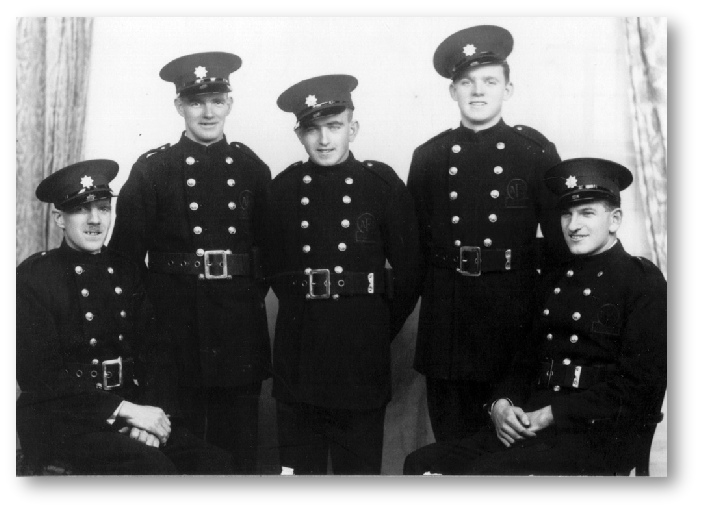
Gargunnock Fire Brigade
This is the wartime fire brigade in all its glory. Left to right Donald McFarlane, son of Donald the Bowl Man and church hall keeper; Harry Paton; Archie McIntyre, George Strang who later did pilot training in Canada. George told me they unfortunately only had one hose which was limited in length and their pump needed to be close to the burn to work.
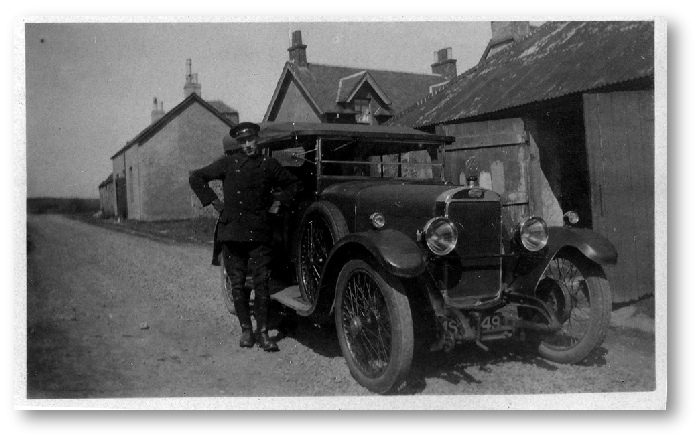
A typical 1920s/30s car in the Main St parked outside Bettyhill Cottage with its chauffeur. Note how open the vista is beyond the Cottage in the background.
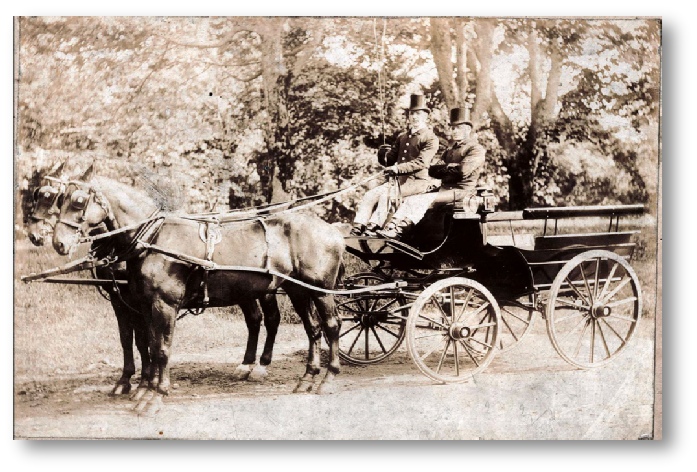
Carriage at Leckie
Jenny Brown allowed me to copy this photo which is of her father when he was a coachman at Leckie for Lord and Lady Younger.

Brenda Cottage
This is one of the small cottages which stood opposite the shop and were demolished to make way for the Gerorge St development.

Bridge over the Forth
This is the wooden bridge which spanned the River Forth down at the Station adjacent to the sawmill. It looks a bit rickety and was latterly hence the obvious attempts at strengthening. There is a story about one carter crossing it with a load for the sawmill and being advised to go have a look at it before recrossing. He did, and decided to go back the long way round.
It was replaced in the mid 30s by a modern reinforced concrete structure much to the relief of all concerned.
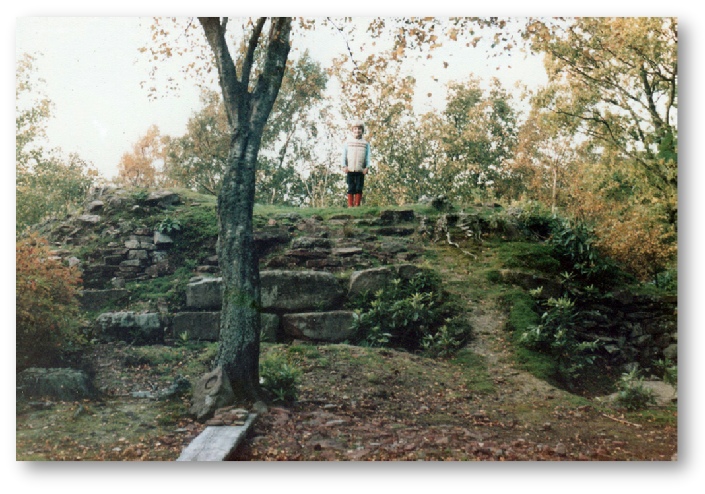
Leckie Broch
Forward now into the era of colour photography, although still about 35 years ago. This is the remains of the Leckie Broch. A few years prior to this the broch had been thoroughly investigated by archaeologists and in the process they had removed all vegetation, particularly rhododendrons although there are signs theyr are beginning to grow back.
The broch, a stone tower-
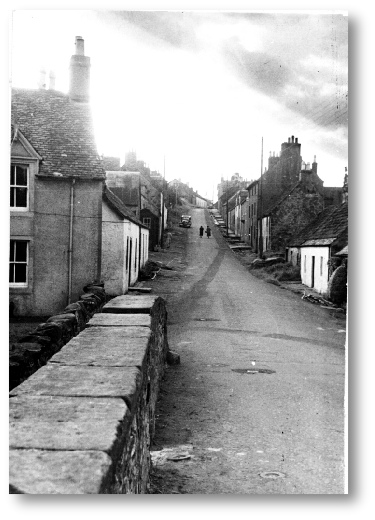
Main St Bridge
This is the only photo I have which records a tiny detail on the bridge which is lost to the casual observer. Taken in the late 50s it shows a gap in the parapet wall which lines up with the path along the burn and allowed pedestrians to emerge onto the road at this point.
Once more cars came on to the roads in the 60s safety considerations dictated that the gap should be filled in and today it is all but invisible to the casual observer.
PHOTOGRAPHS
| History Bytes |
| Statistical Accounts |
| Church History |
| Local Magazines |
| Chronology |
| Parish Magazines |
| Kirkyard Monumental Inscriptions |
| Lower Graveyard Monumental Inscriptions |